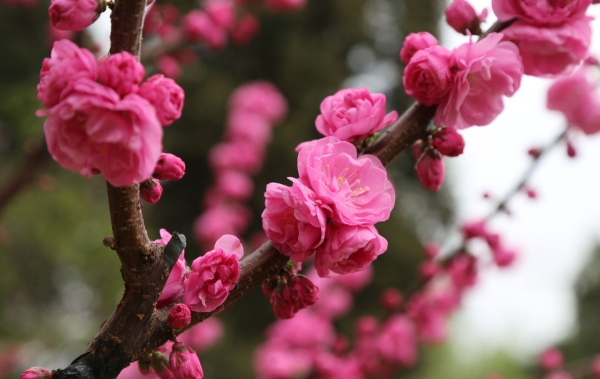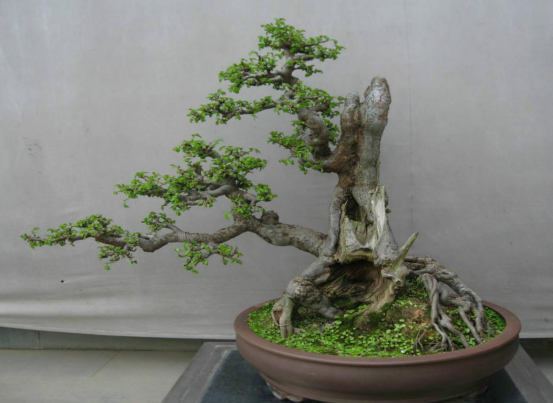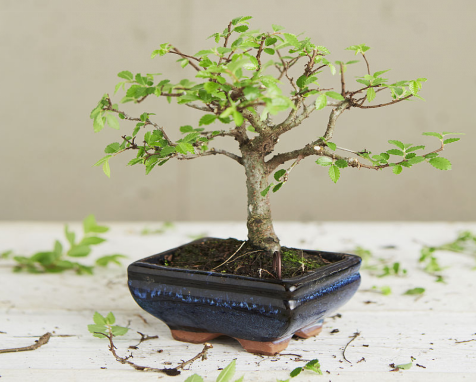Matters needing attention in culturing Prunus mume
Elm leaf plum needs frequent pruning in the growth process, and it is very resistant to pruning. Pruning and combing the branches can reduce the evaporation of water, which can reduce the pressure on the roots.

Have you all learned the pruning methods of green peach and elm leaf plum? I hope the reading of this article can help you!
Culture methods and points for attention of how to raise Prunus mandshurica
The leaves of elm leaves are like elm leaves, and the flowers are named for their resemblance to plum blossoms. Elm leaf plum is very popular and is cultivated all over the country. It is a good ornamental plant. The ornamental effect is better with forsythia, pine and cypress and so on. Then how to raise the elm leaf plum? Then Xiaoqi shared the breeding methods and matters needing attention of the elm leaf plum.
I. Culture methods of Prunus mume
1. Soil: the requirement of soil is not strict, but it is not resistant to waterlogging and prefers neutral to slightly alkaline, fertile and loose sandy loam.
2, watering: avoid waterlogging, planting in spring, if the weather is dry, water 2-3 times, usually no watering, at the same time, pay attention to rainy season drainage.
3. Sunshine: sufficient sunshine can be given in autumn, winter and spring. When keeping it indoors, try to put it in places with bright light, such as well-lit living room, bedroom, study and so on.
4. Temperature: like the warm climate, but the hot and muggy environment in summer is not conducive to its growth; the temperature in winter is very strict, when the ambient temperature stops growing below 10 ℃, it can not survive the winter safely under frost.
5. Insect pests: the main diseases and insect pests of Prunus mandshurica are brown spot, white feather, aphids, stinging moths, red spiders, leaf rollers and so on, which generally occur in summer and autumn, so they should be sprayed and controlled in time.
6. Pruning: pay attention to pruning branches in the process of growth. After the flower fade, cut the flower branches moderately, leaving 3-5 buds on each strong branch. After falling in, prune again, and top and pick the heart, so that the nutrients are concentrated and the flower buds germinate.
II. Matters needing attention in the culture of Prunus mume
In the young stage, the flower branches should be truncated properly after the flower shedding, so as to promote the formation of more lateral branches after axillary bud germination. When the plant is middle-aged and the clump has grown quite dense, you should stop truncating and cut off some of the overdense branches in the clump. After the flower fade, the young fruit should be removed in time, so as not to consume nutrition and affect the flowering in the coming year. It can also be trimmed into a small tree after planting, because the side branches on the trunk of the small tree crown are dense and moderate, and the distribution of nutrients is more reasonable, so it is no longer necessary to remove the young fruit and let the clusters of fruit hang all over the branches, bright red and beautiful. it still has a certain ornamental value. It is necessary to apply topdressing after flowering to facilitate flower bud differentiation and make the flowers large and numerous in the coming year.
The above is the introduction of the breeding methods and matters needing attention of the elm leaf plum. When the flowers are in full bloom in the spring and autumn season, the flower shape and color are extremely beautiful, and it is a rare landscaping plant and household beautification plant.
Culture methods and matters needing attention of Prunus mume
Cultivation methods of Prunus mandshurica
Prunus mandshurica generally grows on slopes or ditches near trees, shrubs, or forest margins at low to middle elevations.
The requirement of soil is not strict, but it grows best in neutral to slightly alkaline fertile and loose soil.
Watering
The root system of elm leaf plum is more developed, drought tolerance is very strong, but it is not resistant to waterlogging, so it is best not to plant in low-lying places, ponds and Weirs.
Planting in spring, if the weather is dry, it should be watered 3 times without watering. At the same time, we should pay attention to the rainy season drainage.
Light
The elm-leaf plum is strong in nature and likes the sun, so it should be planted in places with sufficient light and where there is not enough light, the plants are thin and small, and the number of flowers is small or even unable to bloom.
Fertilizer application
Elm leaf plum likes fertile soil, so attention should be paid to the frequency and quantity of fertilization in the process of conservation, and several shovels of rotten cow and horse manure can be used as base fertilizer when planting.
After entering the normal management in the second year, the flower lags behind in spring every year, the flower bud differentiation period in summer, and fertilizer is applied once before winter.
Matters needing attention in Prunus mandshurica Culture pay attention to cultivation Environment
Prunus mandshurica grows best in sandy loam with good drainage, and can grow normally in plain sandy soil, but it often grows poorly in clay, such as small and yellow leaves, no branching, small or no flowers.
Regular topdressing
Topdressing can be applied twice from May to June to promote plant differentiation of flower buds.
Control the pH value of the soil
Prunus mandshurica has a certain saline-alkali tolerance and can grow normally in saline-alkali soil with a pH value of 8.8 and a salt content of 0.3%.
- Prev

The advantages of making bonsai with elm trees
In addition to introducing the conservation of elm bonsai, the editor also wants to explain why elm bonsai is loved by the general public. The reason why many people choose elm bonsai is that elm is a very ordinary tree species, which is easier to adopt in the mountains. And the branches, leaves and stems of elm have ornamental value.
- Next

Key points of conservation of elm bonsai
1. Elm trees are slightly shady and like light very much, so they should be watered more in summer and autumn and avoid exposure to the sun. Elm trees can be pruned all year round, just remember that in order to prevent excessive bleeding and withered branches, elm trees should not be trimmed on rainy days. 3. Elm loves humus mixed soil (PH5.5-6)
Related
- Fuxing push coffee new agricultural production and marketing class: lack of small-scale processing plants
- Jujube rice field leisure farm deep ploughing Yilan for five years to create a space for organic food and play
- Nongyu Farm-A trial of organic papaya for brave women with advanced technology
- Four points for attention in the prevention and control of diseases and insect pests of edible fungi
- How to add nutrient solution to Edible Fungi
- Is there any good way to control edible fungus mites?
- Open Inoculation Technology of Edible Fungi
- Is there any clever way to use fertilizer for edible fungus in winter?
- What agents are used to kill the pathogens of edible fungi in the mushroom shed?
- Rapid drying of Edible Fungi

